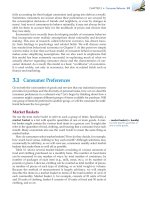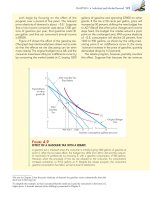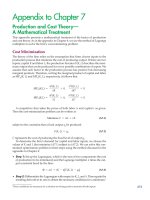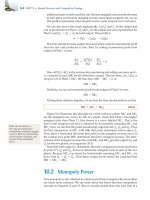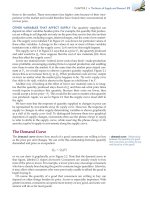(8th edition) (the pearson series in economics) robert pindyck, daniel rubinfeld microecon 263
Bạn đang xem bản rút gọn của tài liệu. Xem và tải ngay bản đầy đủ của tài liệu tại đây (75.13 KB, 1 trang )
238 PART 2 • Producers, Consumers, and Competitive Markets
to produce output at the higher rate. As a result, variable and total costs increase
as the rate of output is increased. On the other hand, if the marginal product of
labor decreases only slightly as the amount of labor is increased, costs will not
rise so quickly when the rate of output is increased.2
Let’s look at the relationship between production and cost in more detail by
concentrating on the costs of a firm that can hire as much labor as it wishes at a
fixed wage w. Recall that marginal cost MC is the change in variable cost for a
1-unit change in output (i.e., ⌬VC/⌬q). But the change in variable cost is the perunit cost of the extra labor w times the amount of extra labor needed to produce
the extra output ⌬L. Because ⌬VCϭw⌬L, it follows that
MC = ⌬VC/⌬q = w⌬L/⌬q
The marginal product of
labor is discussed in §6.2.
Recall from Chapter 6 that the marginal product of labor MPL is the change in output resulting from a 1-unit change in labor input, or ⌬q/⌬L. Therefore, the extra
labor needed to obtain an extra unit of output is ⌬L/⌬q ϭ 1/MPL. As a result,
MC = w/MPL
(7.1)
Equation (7.1) states that when there is only one variable input, the marginal
cost is equal to the price of the input divided by its marginal product. Suppose,
for example, that the marginal product of labor is 3 and the wage rate is $30 per
hour. In that case, 1 hour of labor will increase output by 3 units, so that 1 unit
of output will require 1/3 additional hour of labor and will cost $10. The marginal cost of producing that unit of output is $10, which is equal to the wage,
$30, divided by the marginal product of labor, 3. A low marginal product of
labor means that a large amount of additional labor is needed to produce more
output—a fact that leads, in turn, to a high marginal cost. Conversely, a high
marginal product means that the labor requirement is low, as is the marginal
cost. More generally, whenever the marginal product of labor decreases, the
marginal cost of production increases, and vice versa.3
DIMINISHING MARGINAL RETURNS AND MARGINAL COST Diminishing
marginal returns means that the marginal product of labor declines as the quantity
of labor employed increases. As a result, when there are diminishing marginal
returns, marginal cost will increase as output increases. This can be seen by looking
at the numbers for marginal cost in Table 7.1. For output levels from 0 through 4,
marginal cost is declining; for output levels from 4 through 11, however, marginal
cost is increasing—a reflection of the presence of diminishing marginal returns.
The Shapes of the Cost Curves
Figure 7.1 illustrates how various cost measures change as output changes. The
top part of the figure shows total cost and its two components, variable cost and
fixed cost; the bottom part shows marginal cost and average costs. These cost
curves, which are based on the information in Table 7.1, provide different kinds
of information.
2
We are implicitly assuming that because labor is hired in competitive markets, the payment per unit
of labor used is the same regardless of the firm’s output.
3
With two or more variable inputs, the relationship is more complex. The basic principle, however,
still holds: The greater the productivity of factors, the less the variable cost that the firm must incur
to produce any given level of output.

